The Siam-Burma Railway better known as the infamous “Death Railway”
By Kim Waddoup
The Burma-Siam Railway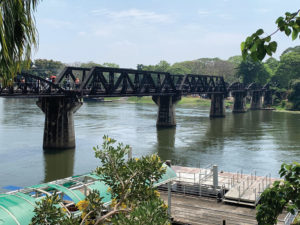 was constructed along the Kwae Noi river valley during World War II, to connect Bangkok with Moulmein (now Mawlamyine) in Burma (now Myanmar). Following the surrender in Singapore, Hong Kong, the Philippines and the Dutch East Indies, the Japanese forces captured more than 140,000 allied prisoners who were packed onto “Hell ships” and sent around Japanese invaded territory . as forced labour one in five prisoners did not survive these terrible, cramped and disease-ridden journeys.
was constructed along the Kwae Noi river valley during World War II, to connect Bangkok with Moulmein (now Mawlamyine) in Burma (now Myanmar). Following the surrender in Singapore, Hong Kong, the Philippines and the Dutch East Indies, the Japanese forces captured more than 140,000 allied prisoners who were packed onto “Hell ships” and sent around Japanese invaded territory . as forced labour one in five prisoners did not survive these terrible, cramped and disease-ridden journeys.
Having lost two decisive sea battles, the Japanese realised that over-land routes were essential for their war plans and with an enormous pool of captive labour, proceeded to construct the Burma Railway. Between June 1942 and October 1943, the Prisoners of War and forced labourers constructed 415 km of track from Ban Pong in Thailand to Thanbyuzayat in Burma. Eight bridges were constructed and 600 trestle bridges to hold the track firmly against the rock face.
Map of the Burma-Thai railway
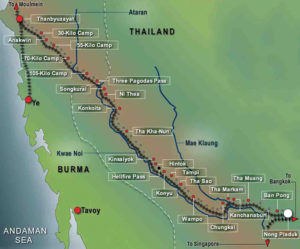 The need to have the railway completed as quickly as possible resulted in massive numbers of prisoners working simultaneously throughout the entire length. Conditions were atrocious through the mosquito-infested jungle with uneven terrain whilst monsoon rains and summer heat compounded their suffering. Equipment was limited they relied on inadequate hand tools, the brute strength of the undernourished prisoners and the viscousness of the guards to ensure progress. It was completed in just 15 months with a tragic loss of human life.
The need to have the railway completed as quickly as possible resulted in massive numbers of prisoners working simultaneously throughout the entire length. Conditions were atrocious through the mosquito-infested jungle with uneven terrain whilst monsoon rains and summer heat compounded their suffering. Equipment was limited they relied on inadequate hand tools, the brute strength of the undernourished prisoners and the viscousness of the guards to ensure progress. It was completed in just 15 months with a tragic loss of human life.
It is estimated that 60,000 allied prisoners worked on the railway together with tens of thousands of forced labourers. They had to work up to 18 hours a day with inadequate food often no more than small portions of rice with contaminated vegetables or fish. Potable water was virtually non-existent resulting in many of the prisoners being dehydrated which then led to dysentery, diarrhoea, cholera and malaria.
To add to their misery, the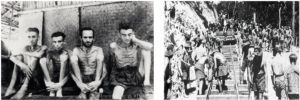 brutality of the Japanese guards has become legendary. It is estimated that more than 12,500 Allied prisoners of war and tens of thousands of forced labourers died. Today, the railway is a testament and lasting memory to all the prisoners who died here with trains still running from Kanchanaburi, over the infamous ‘Bridge on the River
brutality of the Japanese guards has become legendary. It is estimated that more than 12,500 Allied prisoners of war and tens of thousands of forced labourers died. Today, the railway is a testament and lasting memory to all the prisoners who died here with trains still running from Kanchanaburi, over the infamous ‘Bridge on the River
Approximately 80 km north of Kanchanaburi is the Konyu Cutting, better known as Hellfire Pass. Nothing can prepare you for the eyrie feeling of walking along this cutting. It is a sad testimony
to the thousands forced to work here and whilst no track remains, a tree has grown in the pass,The famous movie The Bridge on the River Kwai was based on Pierre Boulle’s 1952 novel and directed by David Lean in 1957. A stirring film it is loosely based on the exploits of Lieutenant Colonel Philip Toosey. Charged with building Bridge 277 over the then-called Mae Klong River, Philip Toosey was portrayed as a collaborator with the Japanese when, in fact, he worked tirelessly to ensure that as many of the prisoners could survive. Much was also done to attempt sly sabotage of the bridge which included collecting termites to eat through the wood.
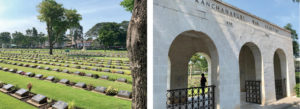 Two bridges were built. First a temporary wooden construction then a few months later the permanent steel and concrete bridge in 1943 which was used for 2 years before being severely damaged by allied bombings in 1945.
Two bridges were built. First a temporary wooden construction then a few months later the permanent steel and concrete bridge in 1943 which was used for 2 years before being severely damaged by allied bombings in 1945.
Alec Guinness as Philip Toosey
A repaired bridge, the one that we see today was reconstructed by donations from Japanese reconciliation funds. Following the success of the film and the subsequent number of tourist arrivals to Kanchanaburi, the name of the Mae Klong River was changed to the River Kwai (Kwae Noi) in 1960. At the end of the war, some survivors remained to assist the Commonwealth War Graves Commission identify thetemporary graves, many of which were in the jungle along the track. Remains were identified and finally laid to rest in two War Cemeteries. The Kanchanaburi War Cemetery (Don-Rak War Cemetery) contains 6,982 graves of British, Australian, and Dutch prisoners with 6,858 being identified. At the Chung Kai War Cemetery are the remains of a further 1,426 British and 313 Dutch prisoners.
6,982 graves in Don-Rak cemetery
Kanchanaburi War Cemetery
Today Kanchanaburi has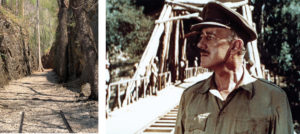 become a major tourist destination just a two-hour drive from Bangkok. A visit to the Death Railway Museum and Research Centre is highly recommended to gain an appreciation of the complexity of the railway and the poor POWs conscripted to build it.
become a major tourist destination just a two-hour drive from Bangkok. A visit to the Death Railway Museum and Research Centre is highly recommended to gain an appreciation of the complexity of the railway and the poor POWs conscripted to build it.
A more recent film, “The Railway Man” depicts the terrible conditions and the long-lasting trauma effects that haunted many of the survivors. There is an excellent performance by Colin Firth who is finally able to lay his ghosts to rest when he meets with a former prison interpreter. The lasting message is one of reconciliation.
“They shall grow not old, as we that are left grow old;
Age shall not weary them, nor the years condemn.
At the going down of the sun and in the morning
We will remember them.”
For the Fallen by Laurence Binyon
